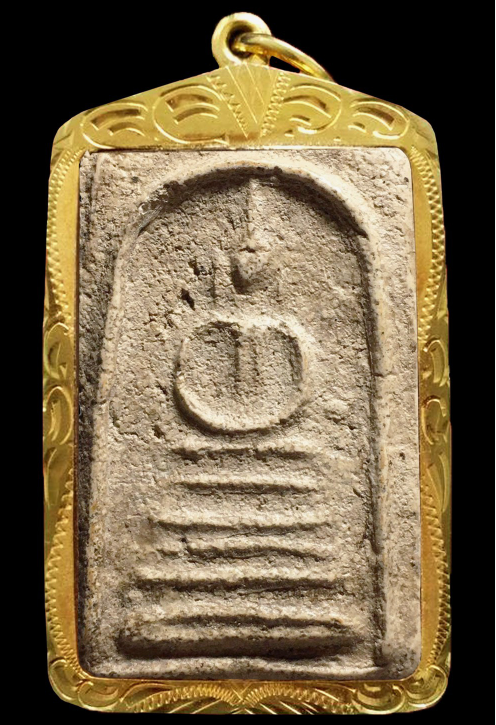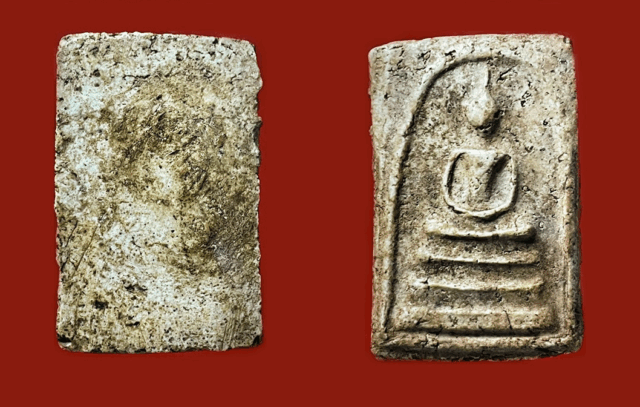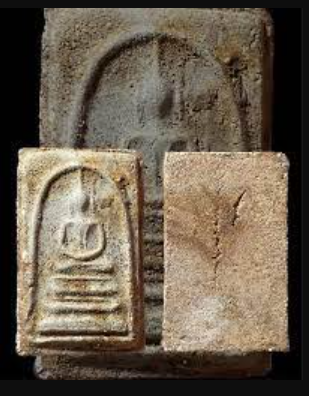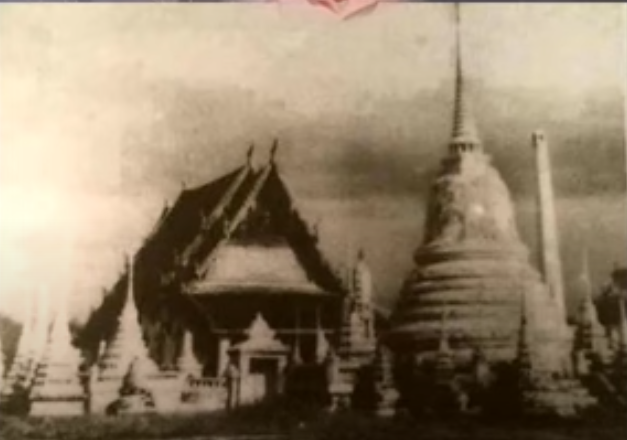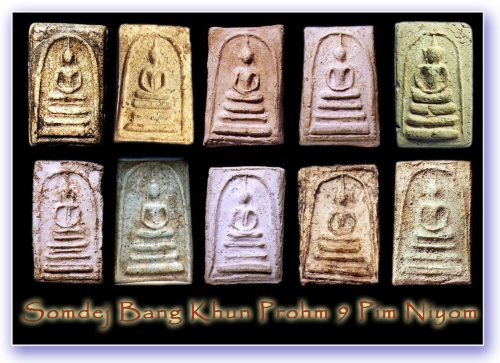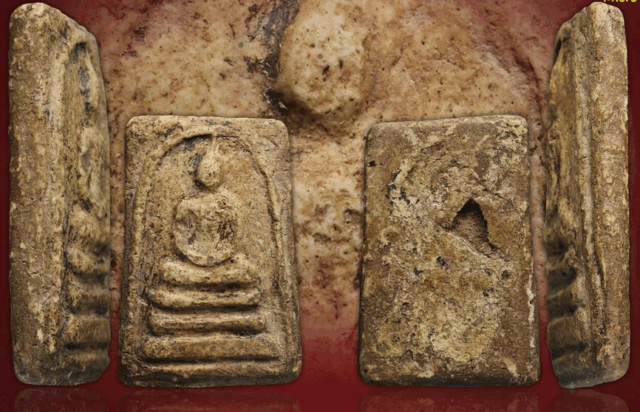
Pra Somdej Wat Bang Khun Prohm
Pra Somdej Wat Bang Khun Prohm is a National heritage left to us by Somdej Pra Puttajarn (Dto) Prohmrangsri since over a hundred years ago. Nowadays, even a piece of broken Wat Bang Khun Prohm Pra Somdej amulet is still something which gets snapped up in high demand, and can fetch extremely high prices.
The Pra Somdej Bang Khun Prohm is one of the Top Five Benjapakee Family of Amulets, and, along with Wat Rakang, Wat Gaes Chaiyo, Wat Pra Kaew, Wat Arun and Wat Intra, one of the most important temples for Pra Somdej amulets. In addition, it is one of the temples where Somdej Pra Puttajarn (Dto) Prohmrangsri would bury his Pra Somdej amulets in the gru at Wat Rakang, Wat Bang Khun Prohm, and Wat Gaes Chaiyo (as well as arguably in some other temples too).
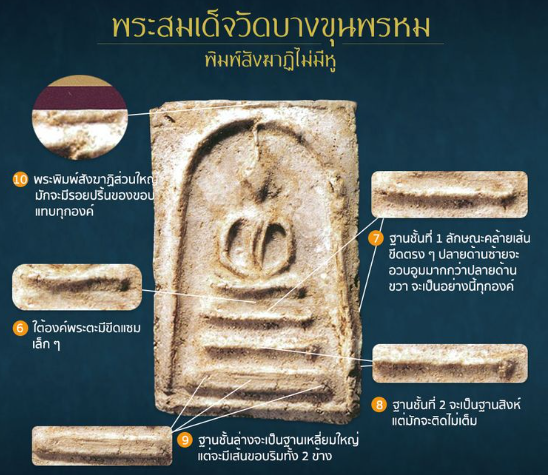
Historical Background
History records that, in the Year of the Dragon 2411 BE, Samian Dtra Duang Tong built Wat Bang Khun Prohm Nai (also known as Wat Mai Amataros), constructing the temple along with a new chedi (stupa) in order to enshrine Pra Somdej amulets. He invited Jao Prakhun Somdej Pra Puttajarn (Dto) Prohmrangsri of Wat Rakhang Kositaram to place there, as well as to empower, the sacred talismans. Somdej Dto made and placed the amulets in the chedi gru at Bang Khun Prohm between 2411 and 2413 BE.
On the evening of the removal, at approximately 8 pm, the very last Pra Somdej amulets were retrieved. Many of them were very thickly coated with “Kraap Gru” (residues and growths).
Recovery and Preservation
The amulets were thereafter permitted to be rented out by devotees until the year 2509 BE. The total funds raised from the rental of these amulets amounted to about 4 million Thai baht. These monies were allocated towards the construction of the new uposadha shrine room and the renovation and restoration of the old chedi stupa, as well as the casting of a bronze statue of Tan Jao Prakhun Somdej Dto. All works were completed and celebrated in 2509 BE, coinciding with the erection of the putta sima (temple walls) and the burial of the “Look Kroo” (teacher’s relics).
“Kraap Gru” and Surface Characteristics
When first unearthed, many amulets exhibited dense accretions of “kraap gru”—organic deposits that form over decades in subterranean chambers. These residues impart a textured patina and are highly prized by collectors, as they bear witness to the amulet’s long‐term interment and spiritual maturation.
Significance of the Gru Interment
The practice of placing amulets within a temple’s gru (hidden chamber) amplifies their sanctity. By allowing the amulets to rest undisturbed for decades, the Buddha’s protective energies are believed to intensify. At Bang Khun Prohm, this ritual interment underscored the temple’s status as a principal repository of Somdej Dto’s talismanic lineage.
Usage and Devotional Practice
Devotees commonly don the Bang Khun Prohm amulet as a personal protective charm. Many immerse themselves in the recitation of the Pra Tammakhant discourses while holding the amulet close, thereby deepening the psychosomatic bond between practitioner and talisman. The ritual chanting of Somdej Dto’s Posture Mantra is particularly associated with this series of amulets.
Architectural and Iconographic Details
- Temple Layout
Wat Bang Khun Prohm Nai comprises the main uposatha, viharn, and the chedi stupa that originally housed the amulet interment chamber. - Chedi Design
The stupa’s architectural form—a multi‐tiered base ascending to a lotus‐capped apex—mirrors the stylized motif found on the so-called “pim chedi” mold type of the amulets.
The Top Five Benjapakee Tradition
Alongside Wat Bang Khun Prohm, the canonical Benjapakee lineage comprises:
- Wat Rakang Kositaram
- Wat Gaes Chaiyo
- Wat Pra Kaew
- Wat Arun
- Wat Intra
These five temples collectively represent the zenith of nineteenth‐century talismanic production under the auspices of Somdej Dto and his contemporaries.
The Pra Somdej Bang Khun Prohm is one of the classic Pra Somdej amuletsPra Somdej amulets available and is along with Pra Somdej Wat Gaes Chaiyo perhaps the next in line to the Pra Somdej Wat Rakang amulet as far as popularity, beauty, sacredness of Puttapisek ceremony and price range. Pra Somdej Bang Khun Prohm Kru Pra Chedi Yai (Large Chedi Kru amulets); The Pra Somdej Bang Khun Prohm amulets classified as a Kru Pra Chedi Yai, have 9 different Pim Song, and were made in the period between 2411 and 2413 BE. These 9 Pim are; Pim Yai, Pim Sangkati, Pim Song Chedi, Pim Prok Po, Pim Gaes Bua Dtum, Pim Thaan Koo, Pim Sen Dai, Pim Ok Krut.
The Pra Somdej Bang Khun Prohm (Wat Mai Amataros) amulet.
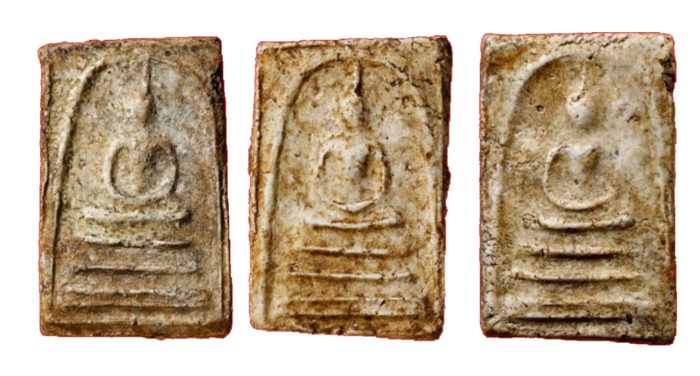
The above examples Of a Pra Somdej Bang Khun Prohm Pim Sen Dai (Kru Chedi Yai), are recommendable objects for reference study and comparison of the Muan Sarn content and Surface features. The clay has condensed and hardened and become shiny like a domino, from passage of time and atmospheric changes. This results in a very smooth surface, which reveals the various characteristics, tonal qualities and markings as well as particles of Muan Sarn present which are in extreme visible evidence.
Roo Khem (needle holes) are visible in the rear faces of Pra Somdej Wat Bang Khun Prohm, as well as ‘Sanim Grapong’ – the red rust particles. The hardness of the amulet to the touch reveals its age. The downward curving lines of the lower double ‘Thaan Saem’ (split Dais model) are a perfect example of the features sought after in a reference model. The cracks are like deep crevices, showing the shrinkage factor of drying over long time periods. “Phiw Jantr’ – Moon surface.
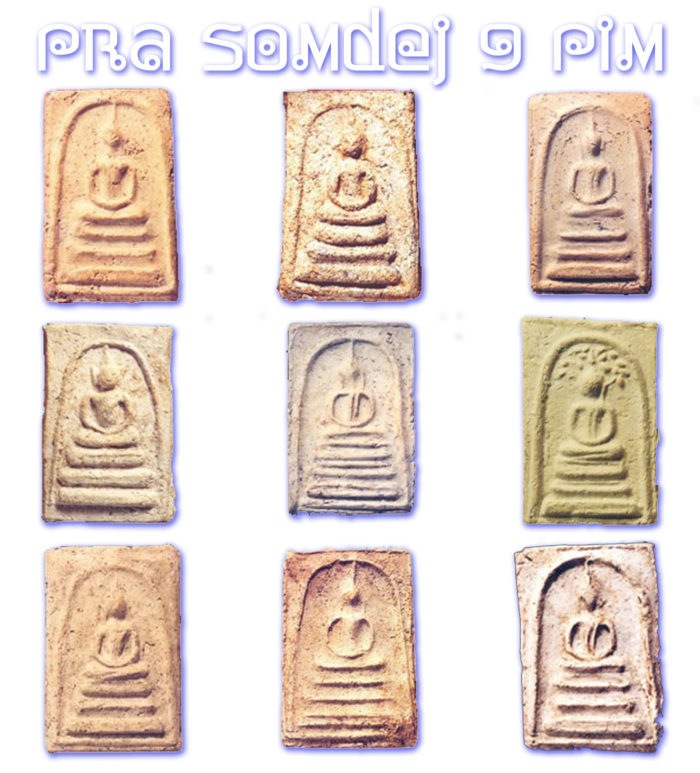
Not all of the Pra Somdej Bang Khun Prohm were placed in the Kru, it took many years to create and press them and many would be in a receptacle in the Kuti and would be handed out by him during the time he created and empowered them. This explains the absence of Kraap Kru, as well as being purely logical and the most probable chain of events to have occurred. The Thaan Saem is one of the 5 Pim Song of Pra Somdej, which exist in both the Kru Wat Rakang and Kru Bang Khun Prohm amulets. Pra Somdej Wat Rakang have Five major category of Pim Song, whereas the Pra Somdej has four more Pim Song, making it nine major Pim in all.
History records that, in the year of the Dragon 2411, Samian Tra Duang Tongoses made restoration work Wat Bang Khun Prohm Nai (Wat Mai Amataros), and renewed the temple along with the building of a new Chedi Stupa, in order to place Pra Somdej amulets, which Samian Tra Duang invited Jao Prakhun Somdej Pra Puttajarn (Toh) Prohmrangsri, of Wat Rakang Kositaram to place there, as well as to empower. The amulets were made in the Somdej Traditional formula of 84,000 pieces (same as the number of suttas of the Pra Tammakhant).
After Somdej Toh had blessed and empowered them, Samian Tra Duang was allowed to place then in the Kru hiding place within the Chedi Stupa behind the Upopsadha shrine room. During the time from then, the Chedi was sometimes accessed and amulets were removed from time to time, and even some thieves dug holes and stole some. This became so bothersome that the Kru had to be broken open officially on 24th November in 2500 BE. The opening took all day, until at approximately 8pm, the very last Pra Somdej amulets were removed. Many of them were very thickly coated with ‘Kraap Kru’ (residues and growths).
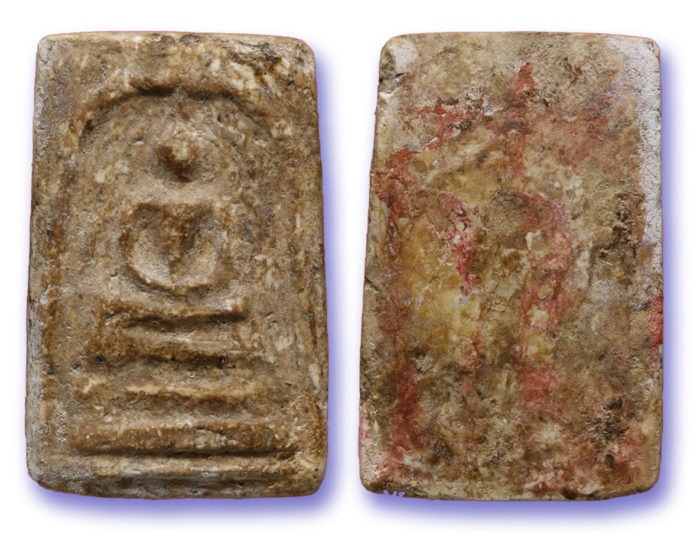
The amulets were allowed to be rented out by devotees, until the year 2509. The total amount of money raised from the rental of these amulets amounted to about 4 Million Thai Baht.
This money was used to construct the new Uposadha shrineroom, and the renovate and restore the old Chedi Stupa, as well as making a bronze statue of Tan Jao Prakhun Somdej Toh, which was completed and celebrated in 2509 at the same time as celebrating the building of the Putta Sima (temple walls), and the burial of the ‘Look Nimit’ (all Uposadha shrine rooms must have a Look Nimit ball buried under it).
Pra Somdej Bang Khun Prohm 2509 BE Masterpiece amulet
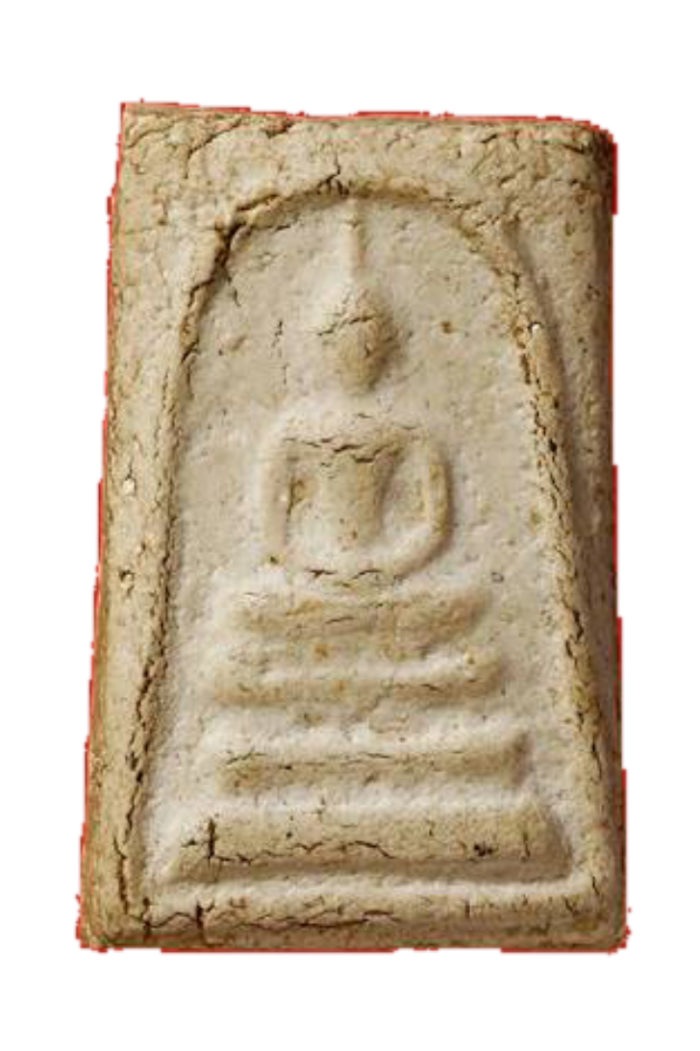
In that year of 2509, a new set of 9 different ‘Pim’ (models) of Pra Somdej amulets were created and released. In addition, a special Pim was released too, namely ‘Pim Saiyaas’ (Sayasana Buddha in laying down position). These 2509 edition amulets were made using the fact that they are almost purely made from ancient Somdej Toh amulets. They thus carry Somdej Toh’s powerful blessing, just as if he had made them.broken pieces of original Somdej Toh Bang Khun Prohm amulets, as part of the Muan Sarn sacred powders. Once again, according to tradition of Pra Somdej making, 84,000 amulets were made.
Apart from the Somdej Toh amulet pieces, broken amulets of Somdej Luang Ta Pan 2502 BE were also added to the mixture, and also from Luang Por Lampu, who both had used pieces of the 2500 BE Kru opening of the Somdej Toh Prohmrangsrit amulets to make their own Pra Somdej.
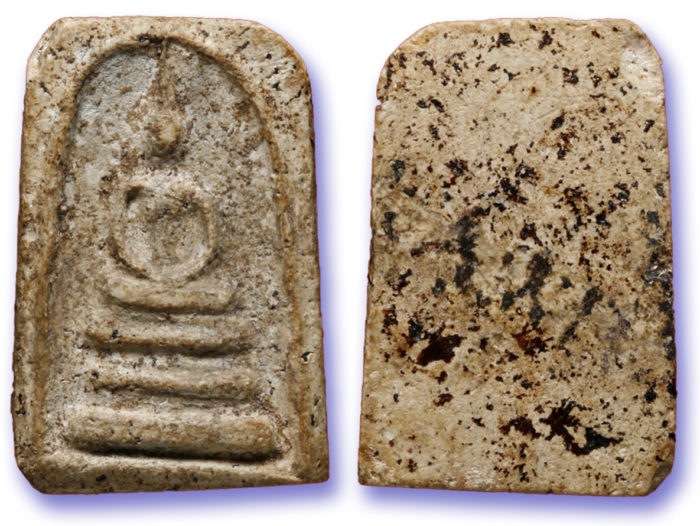
After the Puttapisek empowerment ceremony, the amulets were rented out to devotees at a price of 10 baht each. The remaining amulets which
were not rented after the ceremony on that day were then buried in the Chedi Stupa again. Because of the presence of Muan Sarn sacred powder from both original Somdej Toh amulets, and those from Luang Ta Pan and Luang Por Lampu, this edition recieved immense interest and popularity. This edition of Somdej Bang Khun Prohm, are considered to have extremely powerful Buddha magic in them due to the richness of sacred powders from great masters, and the fact that they are almost purely made from ancient Somdej Toh amulets. They thus carry Somdej Toh’s powerful blessing, just as if he had made them.
Back to Pra Somdej – King of Thai Amulets Main Start Page
